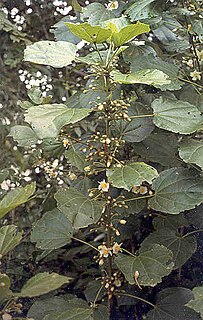
1836 (MDCCCXXXVI) was a leap year starting on Friday of the Gregorian calendar and a leap year starting on Wednesday of the Julian calendar, the 1836th year of the Common Era (CE) and Anno Domini (AD) designations, the 836th year of the 2nd millennium, the 36th year of the 19th century, and the 7th year of the 1830s decade. As of the start of 1836, the Gregorian calendar was 12 days ahead of the Julian calendar, which remained in localized use until 1923.

Celtis is a genus of about 60–70 species of deciduous trees, commonly known as hackberries or nettle trees, widespread in warm temperate regions of the Northern Hemisphere, in southern Europe, southern and eastern Asia, and southern and central North America, south to central Africa, and northern and central South America. The genus is present in the fossil record at least since the Miocene of Europe, and Paleocene of North America and eastern Asia.
Cumbia refers to a number of musical rhythm and folk dance traditions of Latin America, generally involving musical and cultural elements from American Indians, Africans enslaved during colonial times and Europeans. Examples include:

Chinese Peruvians, also known as tusán, are Peruvian citizens whose ancestors came from Guangdong Province in China. They are people of overseas Chinese ancestry born in Peru or who have made Peru their adopted homeland.

Classification of indigenous peoples of the Americas is based upon cultural regions, geography, and linguistics. Anthropologists have named various cultural regions, with fluid boundaries, that are generally agreed upon with some variation. These cultural regions are broadly based upon the locations of indigenous peoples of the Americas from early European and African contact beginning in the late 15th century. When indigenous peoples have been forcibly removed by nation-states, they retain their original geographic classification. Some groups span multiple cultural regions.

A sopaipilla, sopapilla, sopaipa, or cachanga is a kind of fried pastry and a type of quick bread served in several regions with Spanish heritage in the Americas. The word sopaipilla is the diminutive of sopaipa, a word that entered Spanish from the Mozarabic language of Al-Andalus. The original Mozarabic word Xopaipa was used to mean bread soaked in oil. A similar word exists in Hebrew, "copaiba", as this was brought to Northern New Mexico by the Ladino-speaking crypto-Jews who first settled there and laid the foundation for the unique dialect of New Mexican Spanish. The word is derived in turn from the Germanic word suppa, which meant bread soaked in liquid.

Styrax is a genus of about 130 species of large shrubs or small trees in the family Styracaceae, mostly native to warm temperate to tropical regions of the Northern Hemisphere, with the majority in eastern and southeastern Asia, but also crossing the equator in South America. The resin obtained from the tree is called benzoin or storax.

Grindelia (gumweed) is a genus of plants native to the Americas belonging to the sunflower family. The genus was named for Latvian botanist David Hieronymus Grindel, 1776–1836.

The cave swallow is a medium-sized, squarish tailed swallow belonging to the same genus as the more familiar and widespread cliff swallow of North America. The cave swallow, also native to the Americas, nests and roosts primarily in caves and sinkholes.

Astraptes is the genus of flasher butterflies. They belong to the skipper butterfly subfamily Eudaminae, which was long included with the spread-winged skippers (Pyrginae) as a tribe. They are found in the Nearctic and Neotropical ecozones.

Hampea is a genus of flowering plants in the family Malvaceae. They are trees native to Mexico, Central America, and Colombia. There are about 21 species.

Muhlenbergia is a genus of plants in the grass family.

Licania is a genus of over 200 species of trees and shrubs in the family Chrysobalanaceae. Species are found naturally occurring in Neotropical forests from southern Mexico to Brazil and the Lesser Antilles. Due to increased deforestation and loss of habitat, several species have declined, some markedly so, and L. caldasiana from Colombia appears to have gone extinct in recent years. Many species are either rare or restricted in distribution and therefore potentially threatened with future extinction.

Narcosius is a butterfly genus in the family Hesperiidae (Eudaminae).
Luis de Moscoso Alvarado was a Spanish explorer and conquistador. Luis de Moscoso Alvarado assumed command of Hernando De Soto's expedition upon the latter's death.

Astraptes alardus, the frosted flasher, is a species of dicot skipper in the butterfly family Hesperiidae. It is found in the Caribbean Sea, Central America, North America, and South America.
This page is based on this
Wikipedia article Text is available under the
CC BY-SA 4.0 license; additional terms may apply.
Images, videos and audio are available under their respective licenses.















